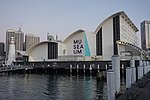HMAS Vampire (D11)

HMAS Vampire was the third of three Australian-built Daring class destroyers serving in the Royal Australian Navy (RAN). One of the first all-welded ships built in Australia, she was constructed at Cockatoo Island Dockyard between 1952 and 1959, and was commissioned into the RAN a day after completion. Vampire was regularly deployed to South East Asia during her career: she was attached to the Far East Strategic Reserve on five occasions, including during the Indonesia-Malaysia Confrontation, and escorted the troop transport HMAS Sydney on six of the latter's twenty-five transport voyages to Vietnam. In 1977, the destroyer was assigned to escort the Royal Yacht Britannia during Queen Elizabeth II and Prince Philip's visit to Australia. In 1980, Vampire was reclassified as a training ship. The warship remained in service until 1986, when she was decommissioned and presented to the Australian National Maritime Museum for preservation as a museum ship; the largest museum-owned object on display in Australia.
Excerpt from the Wikipedia article HMAS Vampire (D11) (License: CC BY-SA 3.0, Authors, Images).HMAS Vampire (D11)
Waterfront Promenade, Sydney Sydney
Geographical coordinates (GPS) Address External links Nearby Places Show on map
Geographical coordinates (GPS)
| Latitude | Longitude |
|---|---|
| N -33.869166666667 ° | E 151.19991666667 ° |
Address
HMAS Vampire
Waterfront Promenade
2000 Sydney, Sydney
New South Wales, Australia
Open on Google Maps










